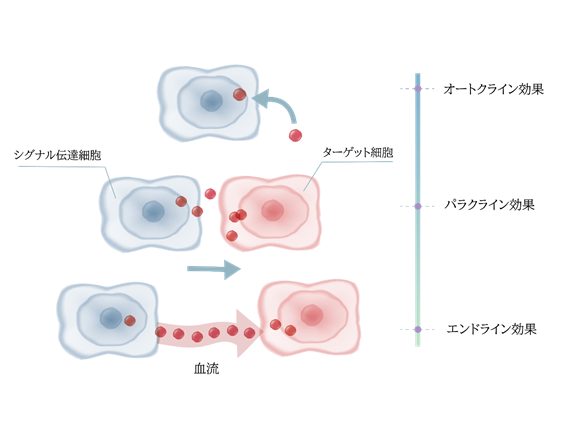We believe that the paracrine effect, in which somatic stem cells release various exosomes, influences the cellular niche, leading to tissue repair and regeneration. Therefore, we are conducting research to maximize this paracrine effect in regenerative therapy.

According to a paper by Takeshi Katsuta and Takahiro Otani from the Molecular and Cellular Therapy Research Field at the National Cancer Center Research Institute, the following description regarding renal diseases is provided:
“In renal diseases, it has been known from studies using various models of acute kidney injury that transplanted MSCs (mesenchymal stem cells derived from the mesodermal connective tissue with multipotent capabilities) act paracrinally on surviving epithelial cells to support tissue regeneration.
Interestingly, the therapeutic effects mediated by exosomes were suggested to involve mRNA transfer. Among these mRNAs are many involved in transcriptional control, proliferation, and immune regulation, suggesting their contribution to tissue regeneration induction.
Subsequent experiments using different animal models have also reported therapeutic effects of MSC-derived exosomes on both acute and chronic kidney injuries.”
Reference: Potential Applications of Mesenchymal Stem Cell-Derived Exosomes in the Development of Novel Therapeutics
URL: https://www.jstage.jst.go.jp/article/dds/29/2/29_140/_pdf
In his recent work, Professor Otiya writes:
“There are also exosomes that perform beneficial functions within the body. These are exosomes secreted from mesenchymal stem cells, which have been a topic of discussion in the field of regenerative medicine. Recently, it has become increasingly clear that many of the disease- and wound-healing abilities of mesenchymal stem cells are mediated by exosomes.” (Katsuda & Ochiya, StemCell Res Ther, 2015).
Furthermore, internationally, in countries such as Singapore and the United States, clinical trials have been initiated to apply exosomes derived from mesenchymal stem cells for disease treatment, and they have been administered to humans. This is indeed a beacon of hope for patients with diseases that current standard treatments cannot effectively address, and for refractory diseases. We hope that by establishing the regulatory science of exosomes, the scientific evidence for their healing effects will be demonstrated, and their clinical application will advance.
※ Exosomes are membrane vesicles with a diameter of approximately 50 to 150 nm secreted by most cells. They are observed in body fluids such as saliva, blood, urine, amniotic fluid, and malignant ascites, as well as being secreted from cultured cells. In recent years, exosomes have been suggested to play a role in transmitting information between distant cells or tissues.
※ The hematopoietic stem cell niche is a microenvironment created by hematopoietic stem cells and supporting cells in the bone marrow.


